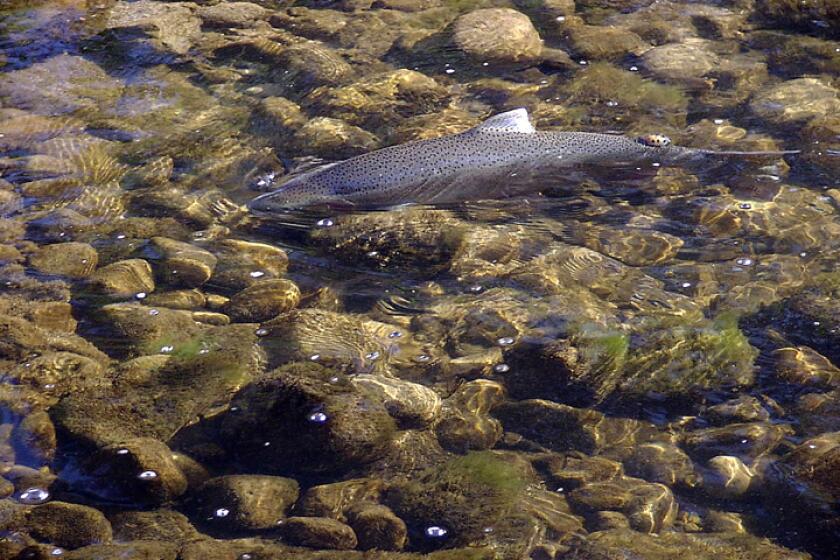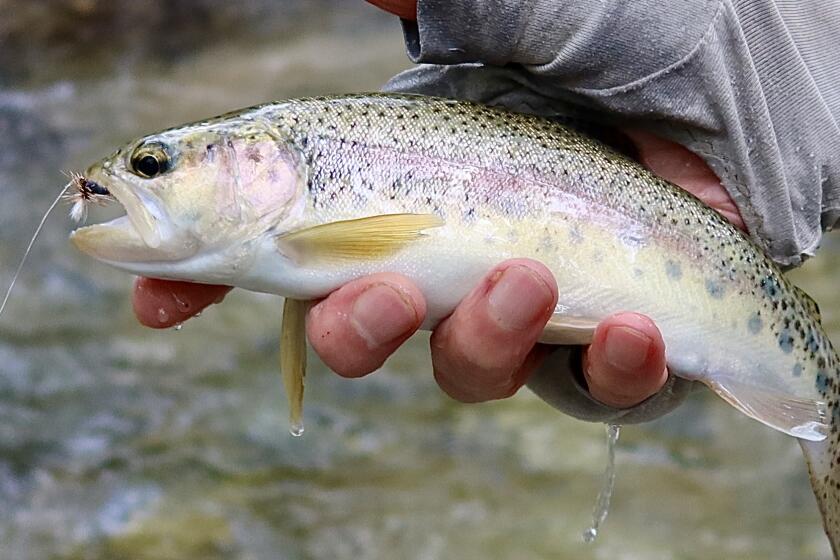Palisades fire threatens last population of steelhead trout in the Santa Monica Mountains

- Share via
- Experts say sediment flowing into the creek where the trout live poses the greatest threat.
- Wildlife officials may opt to temporarily move the endangered fish out of the mountains once it’s safe to do so.
Rain might bring relief from wildfires searing Los Angeles County but could spell disaster for the only known population of Southern California steelhead trout in the Santa Monica Mountains.
The destructive Palisades fire appears to have scorched the entirety of the state and federally endangered trout’s accessible habitat in Topanga Creek, a small coastal mountain stream that drains into the Pacific Ocean. But experts say the secondary effects of the fire are what pose the biggest existential threat.
A heavy storm following a blaze can sweep massive amounts of sediment and charred material from the denuded hillsides into the water they inhabit — a death trap for creatures that can’t flee. Like fish.
“One of our biggest concerns is … losing that last population of fish,” said Kyle Evans, an environmental program manager for the California Department of Fish and Wildlife.
The state agency is already considering a potential rescue plan. But even if the fish survive, experts say the increased frequency of wildfires in the region has lasting negative effects on aquatic life. And some believe the health of the fish is a mirror for that of our society.

Vulnerable populations of rainbow trout are also threatened by the Eaton fire burning in the San Gabriel Mountains north of Los Angeles.
Steelhead trout are the same species as rainbow trout, Oncorhynchus mykiss, but unlike their freshwater-dwelling relatives, steelheads spend much of their lives feeding in the ocean and return to their natal streams to spawn.
Tens of thousands of the silvery fish once returned to Southern California streams every year, to the delight of anglers. They swam most streams of the Santa Monicas, which stretch from the Hollywood Hills to Point Mugu in Ventura County.
Historic photos show fishermen in the Malibu estuary and elsewhere pulling up stringers full of the hefty fish that can grow up to 2 feet, according to Russell Marlow, South Coast senior project manager for California Trout, a conservation group.
Then dams were erected in the region starting in the 1940s, and “that’s when we began to see a pretty precipitous decline in the population,” Marlow said.
A 2012 federal recovery plan reported that fewer than 500 adult Southern California steelhead return annually to natal waters located between southern San Luis Obispo County and the U.S.-Mexico border. It’s likely the figure is much lower today.
The distinct Southern California population was added to the California endangered species list last year.
With the population so depressed, “every fish counts,” Marlow said. He called the Topanga Creek population, which is well-monitored, “extremely important.” The creek is home to 400 to 500 rainbows, which have the potential to venture into the ocean, according to wildlife officials.
Southern California steelhead trout have been pushed to the brink of extinction as their river habitats have been altered by development and fragmented by barriers and dams.
The steelhead of the Santa Monicas have endured numerous trials. In 2018, the Woolsey fire torched miles and miles of the mountains, but not Topanga Creek — a refuge for the fish.
“Topanga is really the only place that they were left,” said Evans, who oversees fisheries programs for the state wildlife agency’s South Coast region. Spared by wildfires, they barely hung on during the drought, he added.
The Palisades fire sparked last week, devastating the West L.A. neighborhood of Pacific Palisades and rampaging through the Santa Monicas.
As soon as it’s safe, Evans said, personnel will trek into the mountains, where the trout live, and determine if they can take any preventive action. That might entail moving the fish to a facility for a few months, to let the “first flush of terrible water kind of get out and then put them back.”
If it’s a go, he said biologists will probably load the trout into buckets or coolers and take them to the closest road. Then they’ll probably be transferred to a truck outfitted with a large tank, aerator and chiller.
“The main things that are going to kill and stress these fish out are either low amounts of oxygen in the water or rapid changes in temperature,” he said.
Although the fish are of immediate concern, experts acknowledge there will be lasting impacts to the ecosystem.
Lee Kats, a biology professor at Pepperdine University who has studied animals in the Santa Monicas for 35 years, said the streams are poised for immense siltation, which “radically changes” the habitat for frogs, salamanders and other freshwater dwellers. It’s a group of animals already struggling worldwide.
Besides the trout, the Santa Monicas are home to imperiled western pond turtles and California red-legged frogs.
With fires in the region now occurring every five to eight years — instead of the historic 15 to 20 years — the impacts are compounded, Kats said.
“As you get increased fire frequency, the streams begin to fill up with silt, and there’s not enough time between fires for those streams to be scoured out and return that habitat to what these animals were used to for thousands of years prior,” Kats said.
Kats said there’s also insufficient time for native plants to spring back, allowing invasive species to crop up. He said his botanist colleagues have noticed a transition in the vegetation, which in turn affects animals.
Groups hope to one day bring back endangered steelhead trout to the Arroyo Seco. For now, they’re trying to improve conditions for the existing freshwater trout.
Where the Eaton fire is burning, wildlife officials said they are particularly concerned about fish inhabiting Santa Anita Creek, which flows through a canyon of the same name to the east of Mt. Wilson, and the Arroyo Seco, which cuts through the foothills communities of La Cañada Flintridge and Altadena.
The fish of the San Gabriels are no stranger to flames. The trout population in the Arroyo Seco, which snakes past the Jet Propulsion Laboratory, was nearly wiped out by the 2009 Station fire, according to a report from last year. Then state biologists moved in 469 rainbows rescued from the San Gabriel River watershed, which biologists feared would perish in the aftermath of the Bobcat fire of 2020.
Following last year’s Bridge fire, which scorched habitat in the East Fork of the San Gabriel River, 503 rainbows — in addition to Santa Ana speckled dace, Santa Ana sucker and arroyo chub — were relocated to nearby streams, Evans said. It was a preemptive move in case debris flows choked the waterway.
But those rainbow trout — identifiable by iridescent colors running down their sides — are blocked from journeying to the ocean and back by man-made barriers. Since they can’t smolt and become steelhead, they do not have state or federal protections.
Marlow, of CalTrout, described the species as one of the best indicators of our overall watershed health, which he said is intertwined with the resilience of our human communities.
“You can connect the the viability of this fish and its continued existence to how we’re doing as as a society in Southern California,” he said.









